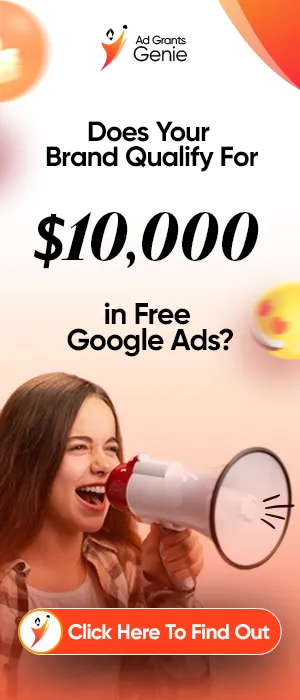As a nonprofit, navigating the world of Google Ads can be overwhelming, but with the Google Ad Grant program, you have a unique opportunity to promote your mission for free. However, securing this grant and using it effectively requires more than just setting up an ad campaign and hoping for the best. To truly harness its power, you need advanced Google Ad Grant strategies that help you stand out in the crowded online space, reach the right audience, and optimize every penny of your grant budget.
In this blog, we’ll dive into some advanced Google Ad Grant strategies to help you maximize your impact, boost your visibility, and achieve your nonprofit goals. Whether you’re an experienced nonprofit marketer or new to the game, these tips will take your nonprofit ad campaigns to the next level.
Leveraging Smart Campaign Structures
One of the first steps in maximizing your Google Ad Grant is creating a well-structured campaign. While it might seem like a simple task, nonprofit ad targeting can be complex, especially when you want to reach the right people at the right time.
Advanced Ad Grants tips include having separate campaigns for different geographic locations, ad groups targeting specific audiences, and specific keywords for each campaign. This level of detail will help your campaigns run smoothly and lead to better performance. For more detailed insights, explore these best practices for managing a Google Ad Grant account.
Audience segmentation is crucial for maximizing your Google Ad Grant impact. Instead of targeting broad categories, you should focus on specific interests, behaviors, and demographics to reach the right audience. For example, if your nonprofit focuses on environmental conservation, targeting users interested in sustainability will increase engagement. Tailoring your messaging to these specific groups helps improve conversions and drive meaningful results.
Geo-targeting further enhances your ad strategy by allowing you to target users in specific locations. This is especially useful for local events or campaigns, as it ensures your ads reach individuals more likely to take action. By refining your geo-targeting based on regions or states, you can better align your message with the audience’s interests and increase the likelihood of success, whether it’s boosting event attendance or spreading awareness for a national cause.

Maximizing Ad Relevance with Dynamic Keywords
Your ad’s relevance to the search query is one of the key factors that influence how well it performs. Maximizing ad relevance should always be top of mind when managing your Google Ad Grant campaigns. One way to enhance relevance is by using dynamic keywords in your ad copy.
Dynamic keywords automatically adjust to reflect the search query entered by the user, ensuring your ad is as relevant as possible. For example, if someone searches for “donate to animal shelter,” your ad could dynamically include the keyword “animal shelter donation,” increasing the likelihood that they’ll click on your ad. Using tools to streamline this process can make a significant difference; discover some useful options in tools for managing Google Ad Grants.
Using A/B Testing to Optimize Performance
A/B testing is a powerful technique for improving ad performance, and it’s especially useful for advanced Google Ad Grant strategies. By running multiple versions of your ads, you can compare which headlines, descriptions, and calls to action resonate most with your audience.
For example, you might test two different headlines like “Help Save Endangered Species” versus “Donate to Protect Endangered Species.” Analyzing the results of these tests will provide you with valuable insights on what works best for your audience.
A/B testing isn’t limited to headlines—it can be applied to landing pages, ad copy, and even bidding strategies. Testing different combinations allows you to identify the best-performing elements of your ads, ultimately helping you improve your overall nonprofit ad campaign strategies.
- Testing Ad Copy
The way you craft your ad copy can make a huge difference in how it performs. It’s not just about catchy slogans; your copy should be clear, persuasive, and action-oriented. Test different variations of your ad copy to see what resonates most with your target audience.
You can test the tone of your ad copy, should it be emotional, informative, or urgent? Or maybe a mix of all three? Keep testing and refining until you find the perfect balance that converts.
- Landing Page Variations
A great ad doesn’t help if your landing page isn’t up to par. When users click on your ad, they expect a seamless experience that leads them to the next step—whether that’s signing up for a newsletter, making a donation, or volunteering.
Testing landing pages is an often-overlooked tactic when optimizing Google Ad Grant campaigns. A simple tweak, like changing the CTA or adjusting the page design, can drastically impact your conversion rates. Advanced tips for nonprofit advertising with Ad Grants should always include testing landing pages to ensure consistency with your ad messaging and provide an optimal user experience.
Integrating Google Analytics for Deeper Insights
If you’re not using Google Analytics to track and analyze your ad campaigns, you’re missing out. Google Analytics provides deep insights into how users interact with your ads and websites. By integrating it with your Google Ads account, you’ll be able to track key metrics like bounce rate, average session duration, and conversion rates.
Using this data, you can refine your Google Ad Grant campaigns, making adjustments to bidding strategies, keyword targeting, and ad copy based on what’s actually driving results.
- Conversion Tracking
Tracking conversions is critical for understanding the effectiveness of your ads. Without this data, you’re essentially flying blind. By setting up conversion tracking, you can measure the impact of your campaigns, from form submissions to donations and event registrations.
If you’re aiming to maximize Google Ads and ensure every dollar counts, tracking conversions is a must. Once you know what’s driving your desired outcomes, you can double down on the strategies that are delivering the best results.
- Behavioral Analytics
Behavioral analytics helps you understand the actions users take once they land on your site after clicking your ad. Are they engaging with content? Are they making donations or filling out forms? This insight allows you to make informed decisions on how to adjust your campaigns.
For instance, if users are clicking on an ad but leaving the landing page quickly, it could indicate a mismatch between your ad copy and landing page or an issue with page speed. By focusing on behavioral analytics, you can uncover opportunities to optimize your ads and landing pages.

Budget Optimization Techniques
You’ve got a fixed monthly budget, and you want to make every penny count. Optimizing your ad spend for nonprofits is key. By using techniques like keyword matching, ad scheduling, and daily budget caps, you can ensure that you’re getting the most out of your Google Ad Grant.
In addition, monitor your campaigns regularly to adjust your budget distribution. If certain campaigns are outperforming others, allocate more funds toward them to boost visibility and drive more conversions.
Exploring New Targeting Options
Google Ads is constantly evolving, and there are always new targeting options to explore. Whether it’s expanding to display ads, using remarketing, or experimenting with affinity audiences, staying up-to-date with the latest targeting features can help you stay ahead of the competition.
For example, remarketing ads can target people who have interacted with your nonprofit in the past but didn’t complete an action, such as donating. This strategy can be especially effective in bringing back engaged users.
Success Stories
It’s not just about theory, real-world success stories can provide valuable insights. One nonprofit that used Google Ad Grants Advanced strategies successfully is the American Red Cross. By refining their targeting, optimizing their campaigns, and leveraging A/B testing, they saw a significant increase in donations and overall campaign performance.
Remember, your goal isn’t just to show up in search results. It’s to connect with people who are passionate about your cause and inspire them to take action. With these advanced Google Ad Grant strategies, you’ll be well on your way to achieving just that.





